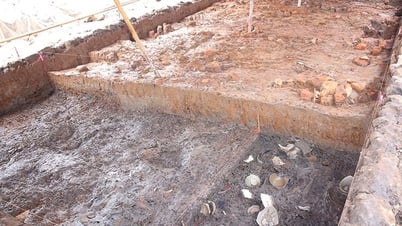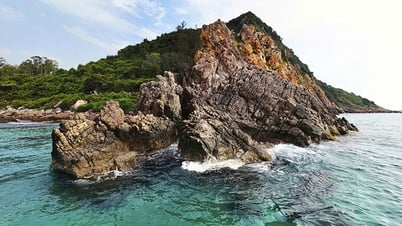On the afternoon of May 7, Director of the Center for Management and Conservation of Hoi An Cultural Heritage ( Quang Nam ) Pham Phu Ngoc said: Initial surveys show that the ancient ship was partially exposed by the waves on December 26, 2023, along the coast of Thinh My, in Cam An ward, Hoi An city. The structure shows some typical features of traditional Southeast Asian ship structures.
The Hoi An Center for Cultural Heritage Management and Conservation has coordinated with the Ho Chi Minh City University of Social Sciences and Humanities and the Quang Nam Museum to conduct a survey and take initial samples for analysis at the site where relics were discovered in the coastal area of Cam An ward (referred to as Cam An ship) as a basis for properly assessing the value and current status, and proposing specific and appropriate plans and solutions for the future of the Cam An ship.
To ensure the collection of samples for analysis, it was necessary to determine the location of the ship because at the time of the sampling survey, the entire ship was buried in the sea sand. Therefore, the survey team exposed a part of the ship's hull as a basis for determining the sampling locations.
At a depth of 1-1.2m, two beams of the ship's skeleton structure are exposed in the first groove and a wooden column that seems to be in the middle of the boat in the second groove. At a depth of 1.5-2m, two more oars connecting three adjacent beams are exposed, while the inner surface of the hull planks tightly connected to the beams, the rafters, the horizontal bulkheads, the vertical bulkheads and the ship's hold are clearly visible.
The specific structure of the ship's parts is as follows: Giang (also known as cong giang or curved tree or rib) is a horizontal reinforcing structure for the ship and contributes to creating the skeleton, including details running longitudinally and evenly spaced inside the ship's side but not connected to the beam (also known as the horizontal beam) but tightly connected to the planks located on the outside to form the ship's hull.
The be-board (also called be) is a wooden plank that covers the hull of a boat and is classified as side or bottom planks depending on the location, nailed to the beams and girders. The be-board is brown in color, where it has been beveled recently, when first exposed it is light brown or light yellowish gray, 7cm thick, with a rectangular cross-section.
Sa crow is also called sa crow floor or deck or boat floor or boat stall. This is the cover that covers the boat or boat compartments, consisting of wooden planks resting on horizontal beams (also called transverse bulkheads or bulkheads) high in the center of the boat and gradually lower on both sides of the boat to form the horizontal curve of the floor.
Bulkheads (also known as bulkheads) are vertical members of a boat's hull that increase the rigidity of the hull, dividing the hull into many watertight compartments, allowing the boat to float even when some of these compartments are flooded.
Initial visual observations determined that the ship was basically made of three different types of wood. Three wood samples were sent to the Forest Industry Research Institute for analysis and appraisal. The appraisal results showed that the Cam An ship was made of the following types of wood: Thanh giang was made of Lagerstroemia wood (most likely Lagerstroemia sp.), the be planks were made of Hopeasp wood, the deck and the bulkheads were made of Pinus sp.
According to Pham Phu Ngoc, Director of the Hoi An Cultural Heritage Management and Preservation Center, to date, in the Southeast Asian sea, more than 20 shipwrecks have been identified as traditional East Sea ships, also known as hybrid ships, dating from between the 14th and 16th centuries.
Thus, the Cam An ship is probably not outside this time frame, most likely dating from between the 14th-15th century to the 16th century. The Cam An ship is a ship with a traditional East Sea design. This is a type of ship that integrates traditional Southeast Asian shipbuilding techniques.
The discovery of the Cam An ship is an important archaeological discovery, opening up opportunities for research on the maritime and commercial history of Hoi An sea in particular and Vietnam's sea in general.
This is also a valuable marine cultural heritage of Vietnam, contributing to enriching the cultural heritage treasure in Hoi An - a world cultural heritage recognized by UNESCO./.
Source: https://www.vietnamplus.vn/quang-nam-tau-dam-o-hoi-an-co-thiet-ke-truyen-thong-dong-nam-a-post1037164.vnp


![[Photo] National Conference "100 years of Vietnamese Revolutionary Press accompanying the glorious cause of the Party and the nation"](https://vphoto.vietnam.vn/thumb/1200x675/vietnam/resource/IMAGE/2025/5/30/1cf6cd5c8a934ebfa347028dcb08358c)
![[Photo] Journalists moved to tears at the Memorial Service for the soldiers who died in Gac Ma](https://vphoto.vietnam.vn/thumb/1200x675/vietnam/resource/IMAGE/2025/5/30/9454613a55c54c16bf8c0efa51883456)

![[Photo] A delegation of 100 journalists from the Vietnam Journalists Association visits the soldiers and people of Truong Sa island district.](https://vphoto.vietnam.vn/thumb/1200x675/vietnam/resource/IMAGE/2025/5/30/0984a986227d4e988177f560d2e1563e)
![[Photo] General Secretary To Lam receives Chief of the Central Office of the Lao People's Revolutionary Party](https://vphoto.vietnam.vn/thumb/1200x675/vietnam/resource/IMAGE/2025/5/30/140435f4b39d4599a3d17975dfb444c5)






















































































Comment (0)